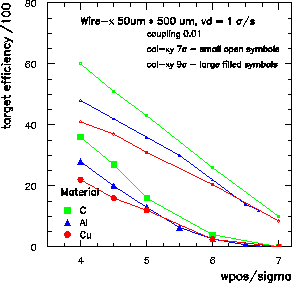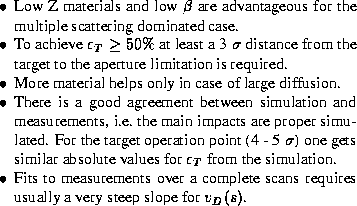


Next: Experimental Setup
Up: The HERA-B Target
Previous: Basic Impacts on a
A simulation program
was developed g[9]
to study the basic properties of a halo target.
Single halo particles are generated and tracked
through the HERA proton machine until they are absorbed in the target
or hit an aperture limitation.
The particle tracking in linear optics uses single turn transport matrices,
coupling is introduced artificially by a skew quadrupole.
Diffusion is taken into account by the former given parametrisation;
scattering and energy loss of protons in the target are simulated, losses
or interactions are calculated.
The simulation contains a lot of parameters, not all of them are
well defined:
- Geometries:
- the detailed information concerning the HERA ring
geometries and its aperture limitation is rather complex and
even not always well known. The simulation uses actually
only one limit in each transversal direction; this seems
to be a proper approach as long the collimator system
defines the narrowest part of HERA.
- Optics:
- The simulation assumes linear optics; the severe
question is, whether the region outside 4
 is
dominated by nonlinear effects. At HERA nonlinear impacts are
expected, e.g. the dynamic aperture or stable resonances
in the halo region. But the very high intrinsic proton lifetime
is an indication that the machine is even for larger betatron
amplitudes in good approximation linear.
is
dominated by nonlinear effects. At HERA nonlinear impacts are
expected, e.g. the dynamic aperture or stable resonances
in the halo region. But the very high intrinsic proton lifetime
is an indication that the machine is even for larger betatron
amplitudes in good approximation linear.
- Diffusion:
- There exists just a poor knowledge and
understanding about diffusion processes in the beam halo.
Statistical physics with its basic transport equations
together with some measured data
provides the frame. The high proton lifetime and the interpretation
of HERA-B target data indicates rather small drift velocities.
A deeper understanding of beam halo dynamics is an important
goal of actual and further target studies,
and the simulation program is therefore a powerful tool.
- Fluctuations:
- The real proton machine shows a wide variety of
fluctuations and disturbances, something what is until yet
neglected in the simulation.
The target efficiency is either limited by diffusion or by
multiple scattering. In the first case more target material and
material with larger Z improves the efficiency. But the HERA-B target is mainly
dominated by multiple scattering .
Fig. 8 shows for this case
the results of simulations with various target
materials and different target positions for collimators located at 7 and
9
.
Fig. 8 shows for this case
the results of simulations with various target
materials and different target positions for collimators located at 7 and
9  .
.

Figure 8: Target efficiency as function of the wire position for various
target materials and two different collimator positions.
The following list tries to summarize the most important results of
the simulations:




Next: Experimental Setup
Up: The HERA-B Target
Previous: Basic Impacts on a
Klaus Ehret
Mon Dec 15 09:36:56 MET 1997

